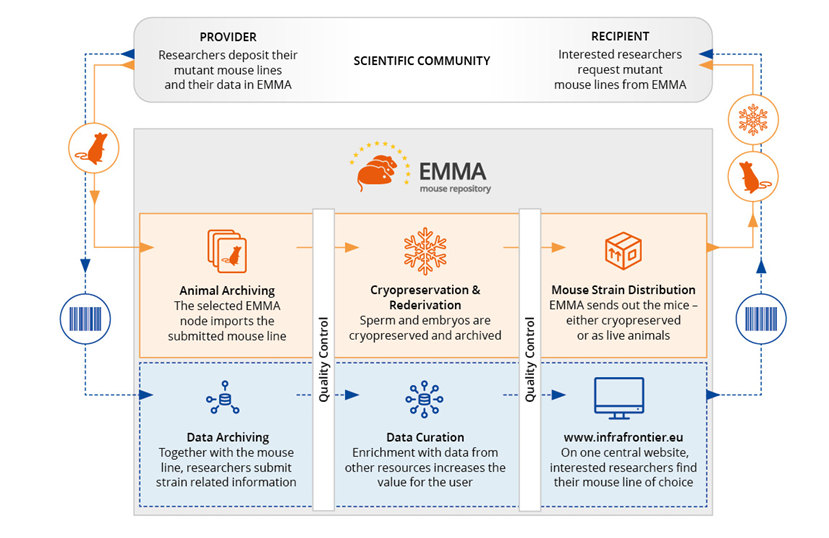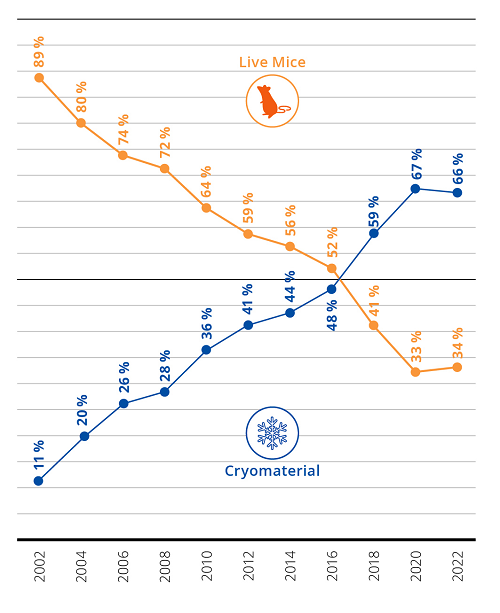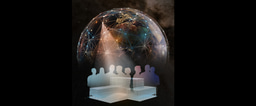EMMA – the European Mouse Mutant Archive at INFRAFRONTIER

INFRAFRONTIER is the European research infrastructure for modelling human diseases and the European Mouse Mutant Archive, EMMA, is one of its core resources. With more than 8,300 mutant mouse strains available, the European Mouse Mutant Archive is the primary mouse repository in Europe and the third largest non-profit repository worldwide. For biomedical researchers all over the globe who are investigating the genetic causes of human diseases, EMMA is an indispensable source of high-quality resources and services, all centrally available through the INFRAFRONTIER website.
EMMA is a non-profit repository for the collection, archiving (via cryopreservation) and distribution of medically relevant mutant mouse and rat strains essential for basic biomedical research. Mouse models are widely considered the most important in vivo mammalian models to study human diseases and EMMA’s physical and digital mouse resources promote their optimum utilisation in biomedical and preclinical research. The offered research tools, and the data and mouse models of human disease, provide an opportunity to develop a better understanding of molecular disease mechanisms and underpin the development of diagnostic, prognostic and therapeutic strategies.
EMMA – Consolidating Europe’s Mouse Strains
In the mid 1990s, the emerging European landscape for biomedical research focused on functional genetic analysis comprised of a vibrant, but scattered research scene. Based on fundamental new insights from huge research programs like the ground-breaking Human Genome Project, clinical research teams all over Europe tried to understand the genetic causes of human health disorders. Hundreds of research teams started to develop specific mutant mouse strains in highly competent, but mostly small and isolated approaches.
In the USA, public laboratories and commercial mouse breeding companies offered the first 'mouse repositories' – centralized archives of mutant mouse lines with specific genetic profiles. Clinical researchers looking for genetically altered mouse models relevant for the research on metabolic, cardiovascular, or other widespread human disorders, could browse the databases and select the strain most appropriate for their specific needs. In Europe, a public lab or company alone could not reach the critical mass to create a similar service. This motivated leading geneticists from different EU member states to form a multinational alliance called the European Mouse Mutant Archive, an open platform for mutant mouse lines and their genetic data. Simultaneously, the EMMA database was developed further to provide a centralised scientific information and distribution platform for the mouse strains submitted to the archive. In 2002, EMMA started the first shipments to the scientific user community.
EMMA – A Scientific Broker for Valuable Mouse Strains and Data
EMMA has become a European success story and today, EMMA is one of the largest non-profit repositories for collecting, archiving and distributing mutant mouse and rat strains as an essential resource for basic biomedical research. Although EMMA is a repository distributed over 11 nodes in 10 European countries, it is perceived by its users as a unified resource, as all EMMA partners apply the same operational and quality standards. Research teams from more than 50 countries worldwide use the EMMA knowledgebase and its scientific services and expertise available at www.infrafrontier.eu. While the EMMA service portfolio has been refined and expanded constantly over time, the main mission has stayed the same: to manage an excellent, unified repository for maintaining scientifically relevant mouse mutants and making them available to the research community – in Europe and worldwide.

EMMA acting as a ‘scientific broker’ for mouse strains and their accompanying data between a ‘supply’ (provider) and ‘demand’ (recipient) side.
The service offered by EMMA is akin to scientific brokerage wherein EMMA archives mouse strains and data, both genotypic and phenotypic, from the ‘supply side’ (mouse strain submitters) and offers them to the ‘demand side‘ (mouse strain requesters) facilitating cutting-edge breakthroughs involving mouse models for human diseases. The professional archiving and distribution of mouse strains is a complicated, expensive and time-consuming task. Eleven well-equipped EMMA nodes that are also leading European research institutes provide this demanding and pivotal service and facilitate open access of this valuable resource to biomedical researchers all over the world. EMMA functions following a non-profit partial cost-recovery model in which submission is basically free while there is a nominal user fee for distribution that covers the costs for sustainable archiving and distribution processes. In addition, EMMA is supported by the partner institutions, national research programs and by the EC's Research and Innovation programmes.
The most important EMMA services include:
- EMMA database: Accessible at infrafrontier.eu, the online catalogue of rodent strains
- Archiving: Scientists who have developed medically relevant mutant mouse strains can submit their models to EMMA for free-of-charge quality controlled state-of-the-art archiving.
- Distribution: Biomedical researchers worldwide can choose and order from more than 8300 EMMA lines for their specific scientific needs.
- User Support: The EMMA’s User Support ([email protected]) is always ready, willing and able to offer expert assistance to any user queries and facilitate an interactive user experience.
- Technology Development & Training: Many INFRAFRONTIER partners offer courses in cryopreservation techniques to promote the efficient and successful use, distribution and derivation of frozen embryos and spermatozoa.
EMMA and Animal Welfare
From the outset, the prevention of unnecessary harm, injury and loss of animal life has been on the forefront of EMMA strategy and development. Working with mutant models that are archived in EMMA has led to significant reductions in local breeding programmes – and to remarkable reductions in the number of animals used in the scientific process. In most cases, specific mouse lines can be used to address several scientific questions and can be archived abolishing the need for continuously maintenance and breeding. Experts estimate that EMMA and other repositories around the world have helped save the lives of hundreds of thousands of mice over the last 20 years. Rapid improvements in cryopreservation technology and archiving methods have led to continuous refinement of the archiving process and reduction in number of mice used.
In recent years, it has become increasingly feasible to deliver frozen embryos or sperm to scientific users rather than live animals. Standardisation of cryopreservation and re-derivation protocols, extensive training activity of potential EMMA users, along with technological advancements have contributed to this trend. This development significantly reduces the transportation stress and other risks faced by the animals.

Frozen and live EMMA shipments: a clear shift from live mice (orange line) to cryopreserved material (blue line)
To further illustrate the success of frozen germplasm shipments, just 10% of shipments involved cryopreserved material during EMMA’s early years; by 2020 this figure covers two thirds. The trend is expected continue in the years to come – thus avoiding needless stress for live animals.
In summary, INFRAFRONTIER and EMMA cater to specialised needs of the international biomedical research community, in terms of providing mouse strains as well as highly curated mouse data, with a strong focus on technological innovation, data management, interactive user support and animal welfare.
Top image of post by INFRAFRONTIER





Join the FEBS Network today
Joining the FEBS Network’s molecular life sciences community enables you to access special content on the site, present your profile, 'follow' contributors, 'comment' on and 'like' content, post your own content, and set up a tailored email digest for updates.